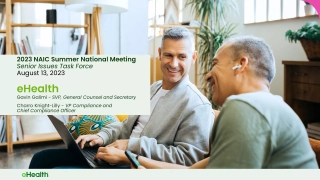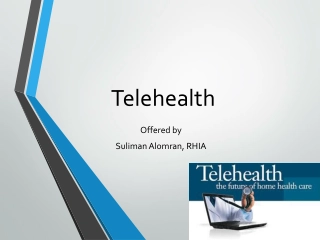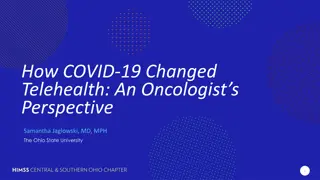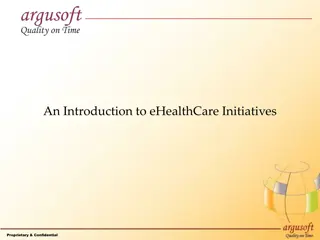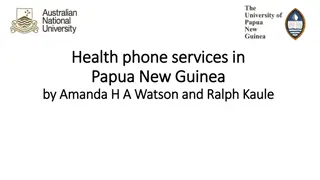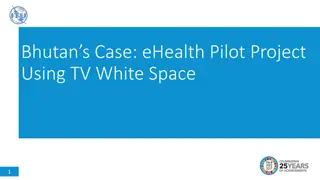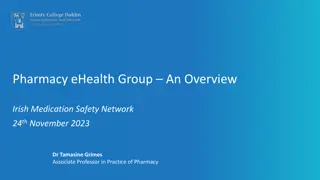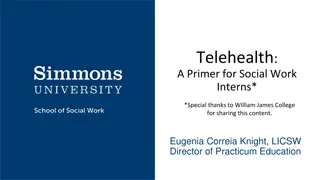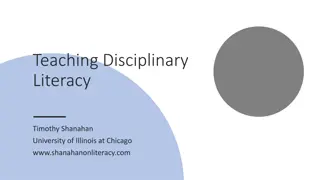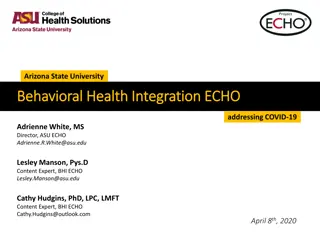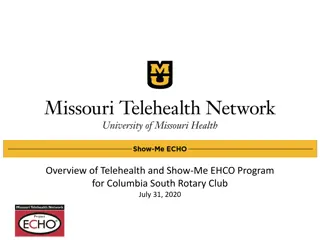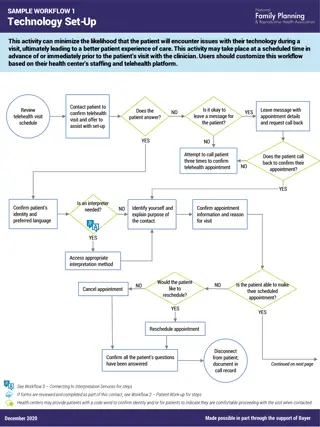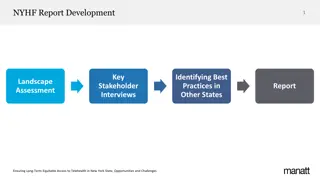Understanding the Impact of eHealth Literacy on Telehealth Preferences Post-COVID-19
The research explores the relationship between eHealth literacy and patient telehealth preferences after the COVID-19 pandemic. It highlights disparities in telehealth use among different demographics, emphasizing the importance of digital literacy for accessing healthcare services. The study aims to determine how eHealth literacy influences telehealth adoption, internet access, technology ownership, and willingness to use telehealth services. By analyzing patient characteristics and eHealth literacy levels, the study sheds light on the implications for healthcare disparities and access to telehealth services.
Download Presentation

Please find below an Image/Link to download the presentation.
The content on the website is provided AS IS for your information and personal use only. It may not be sold, licensed, or shared on other websites without obtaining consent from the author. Download presentation by click this link. If you encounter any issues during the download, it is possible that the publisher has removed the file from their server.
E N D
Presentation Transcript
eHealth Literacy and the Digital Divide After COVID-19: The Impact of eHealth Literacy on Patient Telehealth Preferences Jessica Cheng BA, Nicole Kappel BS, Hannah Vollbrecht MD, Vineet M Arora MD, David O Meltzer MD, Valerie G Press MD MPH
Why study telehealth use during the pandemic? Increases in the use of telehealth mostly occurred among those who are more affluent1 20x increase in telemedicine utilization2 Concerns that pandemic is worsening existing disparities in health care utilization 1 RAND Corporation 2021 2 McKinsey & Company 3 KHN Illustration/Getty Images 2
eHealth Literacy (eHL) eHealth Literacy (eHL):ability to locate, understand and use health information from electronic sources1 Digital Literacy Health Literacy eHealth Literacy during pandemic Telehealth Preferences 1 Richtering et al. 2017 3
Research Aim To determine associations of eHealth literacy with: Telehealth adoption Internet access and technology ownership Willingness to use telehealth Hypothesis We hypothesized that compared to hospitalized adults with adequate eHealth literacy, hospitalized adults with low eHealth literacy would report lower levels of telehealth utilization and willingness to use video technology for telehealth 4
Methods Design: Cross-sectional survey Population: Adult, general medicine inpatients at UCM Time period: 8/2020 8/2021 Measures: Validated eHealth literacy scale (eHEALS) Survey items: technology device ownership and usage, internet access and usage, telemedicine use Analysis: Bivariate: Chi squared tests testing telehealth use by eHL level Multivariable: logistic regressions predicting telehealth willingness 5
Results: Patient Characteristics Patients with inadequate eHL tended to be older, with less education and lower health literacy p-value Characteristic All Adequate eHL Inadequate eHL Participants (N) 266 195 71 Median age (years) 56.5 52 65 <0.01 Female, % 50% 53% 42% 0.1 Race, % 0.2 64% 58% 69% Black 26% 29% 13% White College degree or more, % 34% 39% 21% <0.01 35% 29% 52% <0.01 Low health literacy, % 6
Results: Telehealth Utilization Percentage of Patients Reporting Telehealth Use During the Pandemic 75% ** 66% 63% 59% 50% 31% 25% * 15% 13% 8% 1% 0% Pre-COVID COVID Pre-COVID COVID Phone Video Inadequate eHL (N = 71) Adequate eHL (N = 194) * p<0.05 ** p<0.01 7
Low eHL associated with lower video telehealth use Percentage of Patients Reporting Telehealth Use During the Pandemic 75% ** 66% 63% 59% 50% 31% 25% * 15% 13% 8% 1% 0% Pre-COVID COVID Pre-COVID COVID Phone Video Inadequate eHL (N = 71) Adequate eHL (N = 194) * p<0.05 ** p<0.01 8
Results: Internet and Technology Access Inadequate eHL was associated with lower rates of: Home internet access (p<.01) Smart phone, computer, and tablet ownership (p<.01) Age 65 was not associated with internet access (p=NS) Age 65 was only associated with lower rates of: Tablet ownership (p=.02) 9
Patients with low eHL are less willing to use telehealth Willingness to Use Telehealth by eHL Level 66% * Phone 79% 37% ** Video 74% 0% 10% 20% 30% 40% 50% 60% 70% 80% 90% Inadequate eHL (N = 71) Adequate eHL (N = 195) * p<0.05 ** p<0.01 10
Multivariable logistic regression Health literacy was not a significant predictor for willingness to use telehealth eHealth literacy, along with age, home internet, video capability and computer access, were significant predictors Variables Video Phone Adequate eHealth literacy 2.41 (1.24-4.71)** 1.17 (0.56-2.46) Age < 65 2.30 (1.28-4.14)** 3.38 (1.81-6.29)** Home internet access 2.37 (1.08-5.23)* 1.87 (0.83-4.23) Need help using video 0.36 (0.16-0.85)* 0.81 (0.33-1.99) Low health literacy 1.02 (0.54-1.91) 0.57 (0.30-1.09) Desktop/laptop access 0.85 (0.42-1.70)* Odds ratio (95% confidence interval); ** p<0.01, * p<0.05 11
Limitations Cross-sectional, retrospective survey Generalizability Urban, single-site study Technology use, eHealth literacy measure Self-reported 12
Conclusions We found eHL has a key role in telehealth utilization and telehealth willingness Inadequate eHL less engagement and interest in using video telehealth HL was not a predictor of patient willingness to use telehealth We observed significant telehealth adoption gaps for video, but not for phone eHL measurement captures challenges of digital literacy in video use 13
Acknowledgements The Press Lab: Valerie Press, Nicole Kappel, Mary Akel, Swati Goyal, Nikki Kasal, Sara Salomon, Hannah Vollbrecht, Hospitalist Project: Dr. Vineet Arora, Dr. David Meltzer University of Chicago Pritzker School of Medicine Funding in part by NIH NIA National Institute on Aging (grant #5T35AG029795-14) 14
Extra Slides 15
Brief Health Literacy Screen1,2 Three-question survey: 1. How often do you have problems learning about your medical condition because of difficulty understanding written information? 2. How confident are you filling out medical forms by yourself? 3. How often do you have someone help you read hospital materials? Questions are scored on a Likert scale (0-4) Classified as low health literacy if they have a score of 2 or less on any item 1 - Chew et al., 2004 2 - Chew et al., 2008 16
eHEALS Tool eHEALS scale I know how to find helpful health resources on the Internet I know how to use the internet to answer my health questions I know what health resources are available on the Internet I know where to find helpful health resources on the Internet I know how to use the health information I find on the Internet to help me I have the skills I need to evaluate the health resources I find on the internet I can tell high quality from low quality health resources on the Internet I feel confident in using information from the internet to make health decisions 1 5 Unsure Strongly disagree Strongly agree 17
Internet Access and Technology Ownership Adequate eHL Inadequate eHL ** p-value p-value Characteristic All Age < 65 Age > 65 Participants (N) 266 174 92 195 71 Home internet access 80% 83% 74% 0.10 88% 59% <0.01 Ownership 88% 90% 84% 0.12 94% 70% <0.01 Smartphone, % 60% 62% 55% 0.30 72% 25% <0.01 Computer/laptop, % * 33% 38% 24% 0.02 39% 17% <0.01 Tablet, % 24% 22% 27% 0.33 17% 41% <0.01 Smartphone only, % 3% 9% 0.07 3% 13% <0.01 None, % 5% * p<0.05 ** p<0.01 19


